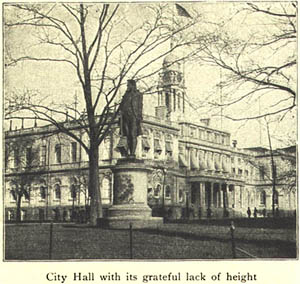A Walk Up-Town
Today, a walk up-town. The University of Houston's College of Engineering presents this series about the machines that make our civilization run, and the people whose ingenuity created them.
Here's an article titled, A Walk Up-Town in New York. It's in Scribner's Magazine, January 1900. Scribner's has just adopted the new technology of including photos, and they really go over the top. Thirty-three photos illustrate the author's stroll from Lower Manhattan up to Central Park -- roughly a four-mile hike.
What we get is an immensely detailed look at the technologies of upscale urban living, just over a century ago. The photos are clearly not from a single eighty-minute period. They show New York in its changing faces. So let's look at pictures:
First, architecture: skyscrapers are entering New York after their recent birth in Chicago. I can make out one twenty-five-story building. But most are still without elevators and limited to six or seven stories. The author stops to visit a skyscraper. He observes, not only elevator operators, but also an elevator starter on the ground floor, to regulate elevator traffic.
 The caption on one photo says, "City Hall with its grateful lack of height." It shows an elegant two-story building. Of course, such land use was doomed in Manhattan. Twelve years later, the eight-hundred-foot Woolworth Building would rise nearby.
The caption on one photo says, "City Hall with its grateful lack of height." It shows an elegant two-story building. Of course, such land use was doomed in Manhattan. Twelve years later, the eight-hundred-foot Woolworth Building would rise nearby.
The photos also show us transportation. Not even the most primitive of the new automobiles appear in the pictures. Later that year, construction of the subway system would begin. That would bring chaos during the next four years.
But that lies ahead. Now we see only cable cars and an infinite variety of horse-drawn vehicles. (New York was among the few cities that'd put in cable cars before the more efficient electric trolley superseded them.) Two photos show firemen battling a blaze with horse-drawn, steam-powered water pumps. Horses pull heavy wagons, graceful carriages, omnibuses, and heavy stagecoaches. It is a world about to be blindsided by unimaginable change.
We have to digest the clothing we see from our century-later perspective -- our clothes are so much simpler. The women wear fancy hats, adorned with bird feathers. Their fitted bodices have large shoulder pads, and they flare out over swirling skirts that almost touch the pavement. Only young girls wear skirts high enough to expose their ankle-high laced-up shoes.
The author remarks that the women "walk independently with an interesting gait." Well, the suffrage movement was still in its infancy, and here it was a seed beneath the snow.
All the men wear hats -- mostly bowlers, and a few stovepipes. Only a few have the new fedoras. Most men wear suit jackets rather like yours and mine, although a few still have frock coats. Vests are common. Neckties are the rule.
The author laments the steady incursion of tall buildings into his genteel world. Well, they called this America's Gilded Age. And, as I look at the pictures, I think to myself, "It'd surely be lovely to visit, but I wouldn't want to live there -- then."
I'm John Lienhard, at the University of Houston, where we're interested in the way inventive minds work.
(Theme music)
J. L. Williams, The Walk Up-Town in New York. Scribner's Magazine, Vol. XXVII, No. 1, Jan. 1900, pp. 44-59.

